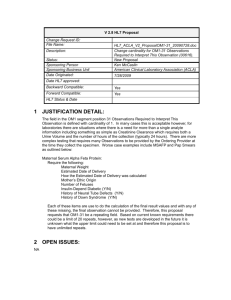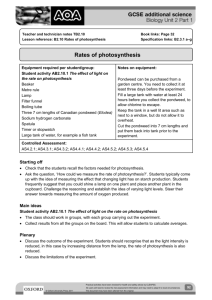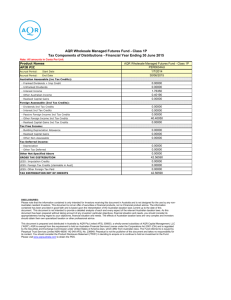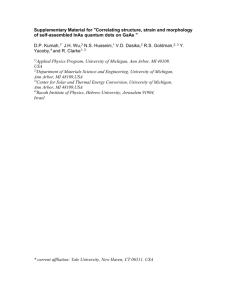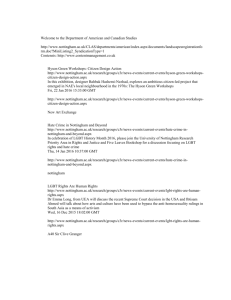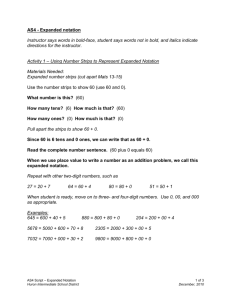AQR Overview - Premium Wealth Management
advertisement
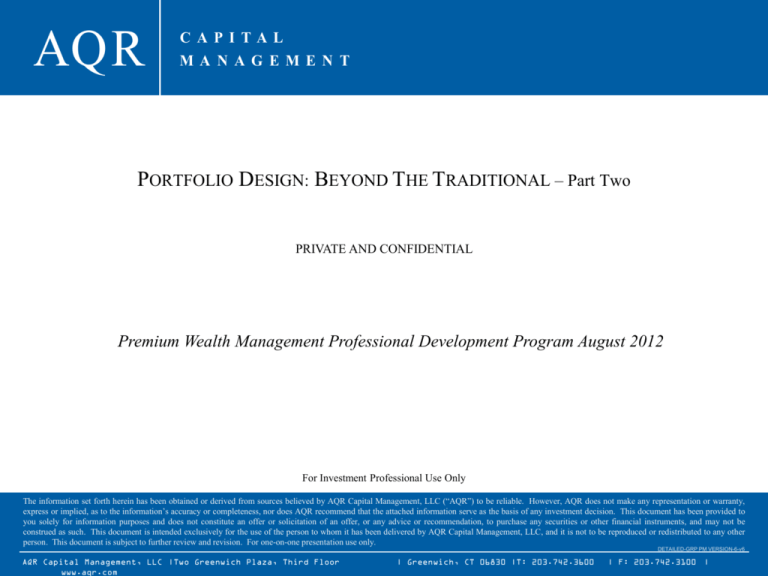
AQR C API TAL MA N AG E ME N T PORTFOLIO DESIGN: BEYOND THE TRADITIONAL – Part Two PRIVATE AND CONFIDENTIAL Premium Wealth Management Professional Development Program August 2012 For Investment Professional Use Only The information set forth herein has been obtained or derived from sources believed by AQR Capital Management, LLC (“AQR”) to be reliable. However, AQR does not make any representation or warranty, express or implied, as to the information’s accuracy or completeness, nor does AQR recommend that the attached information serve as the basis of any investment decision. This document has been provided to you solely for information purposes and does not constitute an offer or solicitation of an offer, or any advice or recommendation, to purchase any securities or other financial instruments, and may not be construed as such. This document is intended exclusively for the use of the person to whom it has been delivered by AQR Capital Management, LLC, and it is not to be reproduced or redistributed to any other person. This document is subject to further review and revision. For one-on-one presentation use only. DETAILED-GRP PM VERSION-6-v6 AQR Capital Management, LLC |Two Greenwich Plaza, Third Floor www.aqr.com | Greenwich, CT 06830 |T: 203.742.3600 | F: 203.742.3100 | Beyond the Traditional Approach Skill Dynamic Exposures Example • Hedge Fund Beta Market Exposures AQR CAPI TAL MA N AG EMEN T 2 Cliff Asness – Managing Director, AQR Capital Management LLC Due to size of Video file unable to upload to Website as its too large – If you require copy of Video file – Contact Roz at Head Office AQR CAPI TAL MA N AG EMEN T 3 AQR DELTA is Correlated to HFs, Not Equities AQR DELTA Strategy* Weak Correlation Strong Correlation 0.1 DELTA to S&P 500 0.2 DELTA to MSCI World 0.5 DELTA to CS/Tremont 0.5 DELTA to HFR FOFs Equity Indices Hedge Fund Indices Strong Correlation 0.7 CS/Tremont to MSCI World; 0.7 to S&P 500 0.7 HFR FOFs to MSCI World; 0.6 to S&P 500 * AQR DELTA Strategy correlations are based on hypothetical net returns. Annual fees used to compute the hypothetical returns are a 1.00% management fee and a 0% performance fee. Correlations are based on hypothetical monthly data from June 2000 – December 2011, denominated in USD. The AQR DELTA Strategy is managed to target 6% annualized volatility, which may be subject to change at any time. Hypothetical fund performance is for illustration purposes only and not the returns to an actual fund or account. Importantly, this backtest does not include tactical strategy allocation. See the Appendix for disclosures relating to hypothetical performance and risks. AQR CAPI TAL MA N AG EMEN T 4 Characteristics of Hedge Fund Risk Premia Dynamic No static exposure to any asset or market Economically intuitive Economic explanation of why the premium is likely to persist Liquid Can be captured by trading liquid instruments Transparent “Lifts the veil" on the drivers of hedge fund returns Alternative Not correlated with traditional asset classes AQR CAPI TAL MA N AG EMEN T 5 Objectives of AQR DELTA Strategy 1 Maintain attractive liquidity and leverage characteristics 2 Realize low correlation to traditional asset class returns 3 Achieve a net Sharpe ratio of at least 0.8 over a complete market cycle AQR CAPI TAL MA N AG EMEN T 6 Strategies Diversified Across 9 Broad Strategy Classes Event Driven Fixed Income Relative Value ARBITRAGE STRATEGIES - Convertible Arbitrage - Event Driven - Fixed Income Relative Value Convertible Arbitrage Equity Market Neutral Managed Futures MACRO STRATEGIES - Global Macro - Managed Futures - Emerging Markets (Macro) EQUITY STRATEGIES - Dedicated Short Bias - Equity Market Neutral - Long/Short Equity - Emerging Markets (Equity) Global Macro Dedicated Short Bias Emerging Markets Arbitrage Strategies Seek to capture relative mispricing between two related assets. Equity Oriented Strategies Seek to take advantage of market inefficiencies that cause specific stocks to be under- or overpriced. Long/Short Equity Macro Strategies Profit from dislocations in global equity, bond, currency and commodity markets, including those driven by investors’ behavioral biases. * Strategies are subject to change at any time without notice. Please see important disclosures in Appendix A5. AQR CAPI TAL MA N AG EMEN T 7 Classic trading strategy: Merger Arbitrage* Example: acquisition of ABC stock by XYZ: XYZ offered 0.86 shares of its stock for each share of ABC, an offer that amounted to $25.40 per share. After the announcement, ABC jumped to $22.18, leaving a deal spread of 14.5% over the following 107 days to expected completion, providing an attractive potential annualised return of 58.7%. The typical arbitrage trade would be to buy ABC stock and to sell short 0.86 XYZ shares for each ABC share purchased. Arbitrageurs who implemented this trade isolated the spread between the two stock prices, and created a market-neutral investment whose primary risk was that of deal failure. * An investment in the above example does not suggest the achievement of a profit or loss, realized or unrealized. This example is used merely to illustrate an investment process. AQR CAPI TAL MA N AG EMEN T Hedge Fund Risk Premia: Mergers & Converts Merger Arbitrage Convertible Arbitrage • Merger arbitrageurs go long the target and, where appropriate, short the acquirer • In doing so, managers offer insurance and provide liquidity to those who held the target’s stock prior to deal announcement • AQR/CNH built a proprietary dataset of 15,000 mergers (going back to 1963) and has been actively managing a merger arbitrage strategy since 2001 • A portfolio can be created by holding some exposure to each announced merger deal • Convertible arbitrageurs buy convertible bonds, which are sold at a discount due to their illiquidity, short the underlying equity and also often seek to hedge out the specific interest rate and credit risk of each issue • At maturity, convertible bonds converge to their theoretical value providing excess returns to owners • AQR built a proprietary dataset of 700,000 convertible prices (going back to 1985) and has been actively managing a convertible arbitrage strategy since 2003 • A portfolio can be created by holding a broad crosssection of well-hedged convertible issues Hypothetical Net Returns to Mergers and Converts Using AQR Proprietary Datasets* Annualized Net Return Merger Arbitrage Convertible Arbitrage Annualized Volatility Sharpe Ratio Max Drawdown S&P 500 Correlations MSCI HFRI World Converts HFRI Mergers 9.8% 5.8% 1.0 -11.7% 0.4 0.4 0.3 0.7 10.0% 5.2% 1.1 -7.8% 0.0 -0.1 0.6 0.2 * These Merger Arbitrage and Convertible Arbitrage backtests use AQR/CNH proprietary datasets on merger arbitrage and convertible arbitrage and assumes constant leverage of 1.5:1 and 2:1, respectively. Annual fees for both backtests are 2.0% management fee and 0% performance fee. Annualized returns, annualized volatilities and correlations are calculated using rolling, quarterly observations from Jan 1990 – Dec 2007 and are USD denominated. Please see important disclosures in Appendix A5 relating to hypothetical performance and risk. AQR CAPI TAL MA N AG EMEN T 9 Managed Futures Trends exist due to investor biases and non-profit seeking market participants End of the trend: reversal to fundamentals (trend strategy exits ) Trend Continuation: Market Price herding and over-reaction Price Fundamental Value Start of the trend: anchoring and under-reaction (trend strategy buys) Catalyst Time These charts are hypothetical examples, and do not represent any actual investments. AQR CAPI TAL MA N AG EMEN T 10 Why Managed Futures? Hypothetical Simple Managed Futures Strategy Returns (Quarterly) Managed Futures Has Performed Well in Bull and Bear Equity Markets 25% 2008 Q4 20% 15% 1999 Q4 1998 Q3 10% 5% 1987 Q4 0% -5% 2008 Q3 2009 Q2 -10% -15% -25% -20% -15% -10% -5% 0% 5% 10% 15% 20% 25% S&P 500 Returns (Quarterly) Source: AQR. For illustrative purposes only; this graph plots quarterly non-overlapping returns of a hypothetical Simple Managed Futures Strategy versus the S&P 500 from January 1985 to December 2011, gross of fees and transaction costs. Please read important disclosures relating to the Simple Managed Futures Strategy as well as hypothetical performance and risks in the Appendix. AQR CAPI TAL MA N AG EMEN T 11 Tactical Risk Allocation III. AQR DELTA ● Hard to differentiate the long term expected performance of strategies ● Strategies can be conditionally attractive/unattractive as the opportunity set changes Model Driven • Estimating expected returns • Assessing conviction of views • Ability to diversify bets Qualitative Information • Market conditions • Industry trends and flows • External factors influencing returns Tactical Tilts ● Modest tilts relative to strategic allocation ● Our Investment Committee provides experienced oversight of our tactical risk weighting AQR CAPI TAL MA N AG EMEN T 13 Strong relative performance since inception DELTA’s* returns have been uncorrelated with traditional markets: • Correlation to MSCI World (ex-Australia) Index in $A -0.1 • Correlation to Barclays Capital Global Aggregate Index (hedged $A) -0.2 AQR Wholesale DELTA Fund Class 1F, UBS Bank Bill and MSCI World December 2009 – June 2012 * AQR Wholesale DELTA Fund Class 1F inception on 01/12/2009. Calculated as the correlation of monthly returns of the AQR Wholesale DELTA Fund, net of fees, and MSCI World (ex-Aust) Index Net Dividends in AUD. AQR CAPI TAL MA N AG EMEN T 14 A5. Performance Disclosures AQR Capital Management, LLC is exempt from the requirement to hold an Australian Financial Services License under the Corporations Act 2001. AQR Capital Management, LLC is regulated by the Securities and Exchange Commission (“SEC”) under United States of America laws and those laws may differ from Australian laws. Please note tat this document has been prepared in accordance with SEC requirements and not Australian laws. This document is distributed in Australia by AQR Pty Limited AFSL 305603, a wholly-owned subsidiary of AQR Capital Management, LLC. The information provided in this document is only intended for investors receiving this document in Australia. This document is not an offer of securities or financial products, nor is it financial product advice. Offers for units in the Fund will only be made under a current product disclosure statement (“PDS”). As this document has been prepared without taking account of any investors’ particular objectives, financial situation and needs, you should consider its appropriateness having regard to your objectives, financial situation and needs. The Fund referred to is issued by Perpetual Trust Services Limited ABN 48000 142 049. Perpetual is not the publisher of this document and takes no responsibility for its content. You should consider the PDS in deciding to acquire or to continue to hold the Fund. Although specific information has been prepared from sources believed to be reliable, we offer no guarantees as to its accuracy or completeness. The information provided in this document is given in good faith and is believed to be accurate at the time of compilation. Neither AQR Capital Management, LLC nor its directors, employees or associates make any representation or warranty as to the accuracy, reliability, timeliness or completeness of the information. If you act on any information in this document, you do so wholly at your own risk. To the extent permissible by law, AQR Capital Management, LLC and its directors and employees disclaim all liability (whether arising in contract, tort, negligence or otherwise) for any error, omission, loss or damage (whether direct, indirect, consequential or otherwise). Please visit www.aqraus.com.au to obtain the PDS. Performance figures quoted in this document are past performance. Past performance is not an indicator of future performance. Neither AQR Capital Management, LLC nor its directors, employees or associates guarantee or make any representation as to the performance of the Fund, the maintenance or repayment of capital, the price at which units may trade or any particular rate of return. Performance figures are calculated in accordance with the Investment & Financial Services Association (IFSA) standards. Total returns (post fee) are calculated: to the last day of each month using exit prices; taking into account management costs of the fund; assuming reinvestment of distributions (which may include net realized capital gains from the sale of assets of the Fund). No reduction is made to the unit price (or performance) to allow for tax you may pay as an investor. Certain other fees such as Contribution fees or Withdrawal fees (if any) are not taken into account. The allocation to hedge fund strategies are constantly under review, and may change at any time. All indices are copyrighted by and proprietary to the issuer of the index. Investments are subject to investment risk, including possible delays in repayment and loss of income and principal invested. The fund has exposure to the gains and losses of commodities, futures, options, derivatives and other financial instruments. The information set forth herein has been provided to you as secondary information and should not be the primary source for any investment or allocation decision. Please obtain the advice of your fiduciary prior to any investment. The information set forth herein has been obtained or derived from sources believed by AQR to be reliable. However, AQR does not make any representation or warranty, express or implied, as to the information’s accuracy or completeness, nor does AQR recommend that the attached information serve as the basis of any investment decision. This document has been provided to you solely for information purposes and does not constitute an offer or solicitation of an offer, or any advice or recommendation, to purchase any securities or other financial instruments, and may not be construed as such. This document is intended exclusively for the use of the person to whom it has been delivered by AQR, and it is not to be reproduced or redistributed to any other person. The information contained herein does not constitute legal, tax or accounting advice or investment advice and is solely based on the opinion of AQR of which no expectation of compensation will be derived. The recipient should conduct his or her own analysis and consult with professional advisors prior to making any investment decisions. Any investment made will be in the sole discretion of the reader. Past performance is not an indication of future performance. Diversification does not eliminate the risk of experiencing investment losses. Gross performance results do not reflect the deduction of investment advisory fees, which would reduce an investor’s actual return. For example, assume that $1 million is invested in an account with the Firm, and this account achieves a 10% compounded annualized return, gross of fees, for five years. At the end of five years that account would grow to $1,610,510 before the deduction of management fees. Assuming management fees of 1.00% per year are deducted monthly from the account, the value of the account at the end of five years would be $1,532,886 and the annualized rate of return would be 8.92%. For a ten-year period, the ending dollar values before and after fees would be $2,593,742 and $2,349,739, respectively. AQR’s asset based fees may range up to 2.85% of assets under management, and are generally billed monthly or quarterly at the commencement of the calendar month or quarter during which AQR will perform the services to which the fees relate. Performance fees are generally equal to 20% of net realized and unrealized profits each year, after restoration of any losses carried forward from prior years. In addition, AQR funds incur expenses (including start-up, legal, accounting, audit, administrative and regulatory expenses) and may have redemption or withdrawal charges up to 2% based on gross redemption or withdrawal proceeds. Please refer to the Fund’s Private Offering Memoranda and AQR’s ADV 2A for more information on fees. Consultants supplied with gross results are to use this data in accordance with SEC, CFTC, NFA or the applicable jurisdiction’s guidelines. Unless otherwise noted, the net performance data presented reflects the deduction of annual management fees (payable quarterly in advance) and annual performance fees (payable annually in arrears, if due) plus expenses (start-up costs, legal, accounting, audit, administration, etc.). Please note, as we have several different share classes available, and multiple feeders being offered at varying volatility levels with varying fee arrangements, the performance numbers above are not representative of all investors or achievable by all investors. Please note that the net returns presented here (both MTD and YTD) are based on the assumption that an investor contributed money to the fund at the start of the year (or at inception if returns start in a month other than January in the given year) and had no subsequent contributions and redemptions thereafter. Interim contributions and redemptions can affect the net return of an investment in the fund based on the timing and may vary significantly from the returns above (depending on the amount of incentive fee that has been accrued to date). Please inquire at AQR for more specific net returns. AQR CAPI TAL MA N AG EMEN T 15 A5. Performance Disclosures Hypothetical performance results (e.g., quantitative backtests) have many inherent limitations, some of which, but not all, are described herein. No representation is being made that any fund or account will or is likely to achieve profits or losses similar to those shown herein. In fact, there are frequently sharp differences between hypothetical performance results and the actual results subsequently realized by any particular trading program. One of the limitations of hypothetical performance results is that they are generally prepared with the benefit of hindsight. In addition, hypothetical trading does not involve financial risk, and no hypothetical trading record can completely account for the impact of financial risk in actual trading. For example, the ability to withstand losses or adhere to a particular trading program in spite of trading losses are material points which can adversely affect actual trading results. The hypothetical performance results contained herein represent the application of the quantitative models as currently in effect on the date first written above and there can be no assurance that the models will remain the same in the future or that an application of the current models in the future will produce similar results because the relevant market and economic conditions that prevailed during the hypothetical performance period will not necessarily recur. There are numerous other factors related to the markets in general or to the implementation of any specific trading program which cannot be fully accounted for in the preparation of hypothetical performance results, all of which can adversely affect actual trading results. Hypothetical performance results are presented for illustrative purposes only. Hypothetical Simple Managed Futures Strategy: This hypothetical strategy trades 58 highly liquid futures and currency forwards during the period from January 1985 to December 2011. To determine the direction of the trend in each asset, the strategy considers the excess return over cash of each asset for the prior 12 months. The portfolio takes a long position if the return was positive and a short position if the return was negative. The strategy always holds positions in each of 24 commodity futures, 9 equity index futures, 13 bond futures and 12 currency forwards. The size of each position is determined by volatility, with a target of 0.60% annualized volatility for each asset (this target volatility was selected to yield an average portfolio volatility of around 9-10%. The model estimates future volatility for each asset based on the most recent 60 days). This yields a portfolio that is equal risk weighted across the instruments to provide diversification and to limit the portfolio risk from any one asset. (See Ooi and Pedersen (2009) for further details on the strategy.) The portfolio is rebalanced at the end of each month. Convertible bond securities may be considered illiquid securities, which cannot be sold or disposed of in the ordinary course of business at approximately the prices at which they are valued. Difficulty in selling securities may also result in a loss or may be costly to an investment portfolio. There is a risk of substantial loss associated with trading commodities, futures, options, derivatives and other financial instruments. Before trading, investors should carefully consider their financial position and risk tolerance to determine if the proposed trading style is appropriate. Investors should realize that when trading futures, commodities, options, derivatives and other financial instruments one could lose the full balance of their account. It is also possible to lose more than the initial deposit when trading derivatives or using leverage. All funds committed to such a trading strategy should be purely risk capital. AQR CAPI TAL MA N AG EMEN T 16


